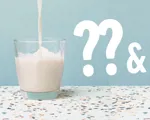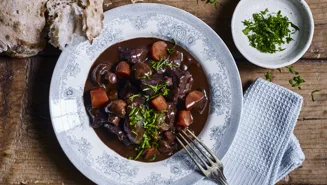
Welcome to the flavourful realm of lactose-free foods. In this article, we look at dairy products where lactose has been actively removed through different processes to make them lactose-free.
We also go through some foods that do not contain lactose, although they are not labelled lactose-free, as this requires a process of removing lactose. This process does not take place if the food does not contain any lactose to begin with.
What is lactose-free food?
Simply put, they are dairy products like milk, butter, and cheese that have had their lactose removed. Lactose is the milk sugar naturally occurring in milk from mammals like cows, sheep, and goats.
It or its derivatives are also used as an ingredient in various processed foods such as baked goods, breakfast cereals, and processed meats, but more on that further down. For now, keep reading about different lactose-free dairy products.
And, if you are in doubt about lactose-free food or lactose in your diet in general, always consult a healthcare professional.

Lactose-free milk
Lactose-free milk retains the creamy texture and delicious taste that traditional milk offers. From skimmed to full-fat versions, lactose-free milk and milk drinks are just as perfect as the regular versions for a delicious glass of cold milk or used in cooking or baking.
Lactose-free butter
Another dairy staple is butter, and you can easily enjoy butter without lactose. It has the same rich mouthfeel that you love from spreading on toast to using in savoury cooking, with the well-known velvety richness that its regular counterpart provides.
Lactose-free yoghurt
You can also get tangy, delicious yoghurt without lactose. From classic yoghurt to Greek yoghurt and Greek-style yoghurt, they deliver the same tangy satisfaction as their regular counterparts. You will experience the same creamy, velvety texture of different yoghurts and the well-known, beloved tangy flavour, and you can use it just like you would regular yoghurt.
Lactose-free cream
As the dairy product that forms the basis of many decadent desserts and rich sauces, you have, of course, also the option of lactose-free cream. It offers the same velvety texture, allowing you to whip up your favourite dishes.
Lactose-free cheese
Lastly, we come to cheese, and you can also enjoy different types of lactose-free cheese with the flavours and textures that you love. The cheeses go through a special process to remove the lactose completely, but the process might differ from one cheese to another depending on its characteristics. You can read more about this in our article 'What is lactose-free cheese?'.
What is the difference between lactose-free and dairy-free?
Before diving deeper into the world of food without lactose as well as lactose-free food, let us have a quick look at the terms 'lactose-free' and 'dairy-free':
Lactose-free: These products originate from dairy but have had lactose (milk sugar) removed. They may still contain other dairy components.
Dairy-free: These products contain no milk components whatsoever, and because of this, they also do not have any lactose.
If you want to know more about this, check out our article 'Is lactose-free dairy-free?'.
How to identify lactose in foods?
It is usually not stated directly on the packaging if a product contains lactose. Often, the components of the food are stated, but you need to know where lactose can be found to benefit from that information. Most people know that milk contains lactose, but the ingredients list can also include, for example, milk solids, whey, and milk sugar.
Here are some tips to help you identify which foods do not have lactose:
Check the labelling: Some products are specifically labelled ‘lactose-free’, which means they are actively produced not to contain lactose. If the label says ‘dairy-free’ or ‘non-dairy’, however, there is no guarantee it is completely without lactose or other milk derivatives. This means you should always check the ingredients list to be sure.
Check the ingredients list: Foods that contain lactose often have words like ‘milk’, ‘whey’, ‘curds’, ‘milk by-products’, ‘dry milk solids’, or ‘non-fat dry milk powder’ in the ingredients list.
Know your foods: The most common sources of lactose are dairy products, including cheese, butter, cream, and yoghurt. Processed foods like bread, cereal, salad dressings, mixed seasonings, and snacks like cookies and candies can also contain lactose.
What foods do not have lactose?

As mentioned, many foods do not contain lactose, aside from dairy products that are made lactose-free. These are, for example, fruits, vegetables, unprocessed meats, poultry, fish, eggs, and legumes. The same goes for grains and cereals, such as rice and oatmeal, as well as nuts and seeds. However, always check the ingredients list to make sure there are no lactose derivatives.
Plant-based oils and spreads do not contain lactose either and are good for cooking or flavouring dishes. For a dairy-like feel, go for plant-based products made from soy, almond, oat, or the like.
Fats and oils
There are various fats and oils for cooking, baking, dressing salads, and more that do not contain lactose. Vegetable oils, such as olive oil or sunflower oil, do not contain lactose. And, as a bonus, they add different flavours to your meals depending on which one you choose. Use them to make delicious oil dressings, for example, vinaigrettes. Creamy dressings might have dairy, so remember to check the label.
Mayonnaise is a popular condiment which also does not have lactose as it is made of eggs, oil, and either vinegar or lemon juice.
Bread
While most bread types do not contain lactose, it may find its way into the recipe through certain additives used for enhancing flavour, texture, or shelf-life.
However, several types of bread are typically made without lactose, like rye bread, sourdough bread, focaccia, and baguettes. They are usually made with a combination of flour, salt, water, and sometimes yeast, in other words, no dairy products. When in doubt, refer to the ingredient label or inquire directly with the baker.
Chocolate
High-quality dark chocolate is typically without lactose, especially those with a cocoa content ranging from 70 % to 99 %. Since it is often made of cocoa solids and cocoa butter, it typically does not contain lactose. However, some brands might add milk or milk derivatives so always check the labels. On the flip side, milk and white chocolate contain milk, in other words, lactose. Read more in our article about lactose-free chocolate.
Fruit and vegetables
Unsurprisingly, fruits and vegetables do not contain lactose. Whether frozen, fresh, homegrown, or canned, they have no lactose. However, if you buy fruits and vegetables that are already chopped or mixed with other ingredients, they might contain milk derivatives. So, always read the labels to make sure there is no dairy added.
Dairy-free plant-based products
Dairy-free foods do not contain milk or its derivatives. Examples include almond and soy drinks, but also fruits and vegetables, many grains like rice and oats, beans and lentils, and meats.
However, it is important to note that there is a difference between dairy-free and lactose-free as mentioned above. In short, dairy-free products never contain lactose, but lactose-free products are not always dairy-free, which is an important distinction.







































